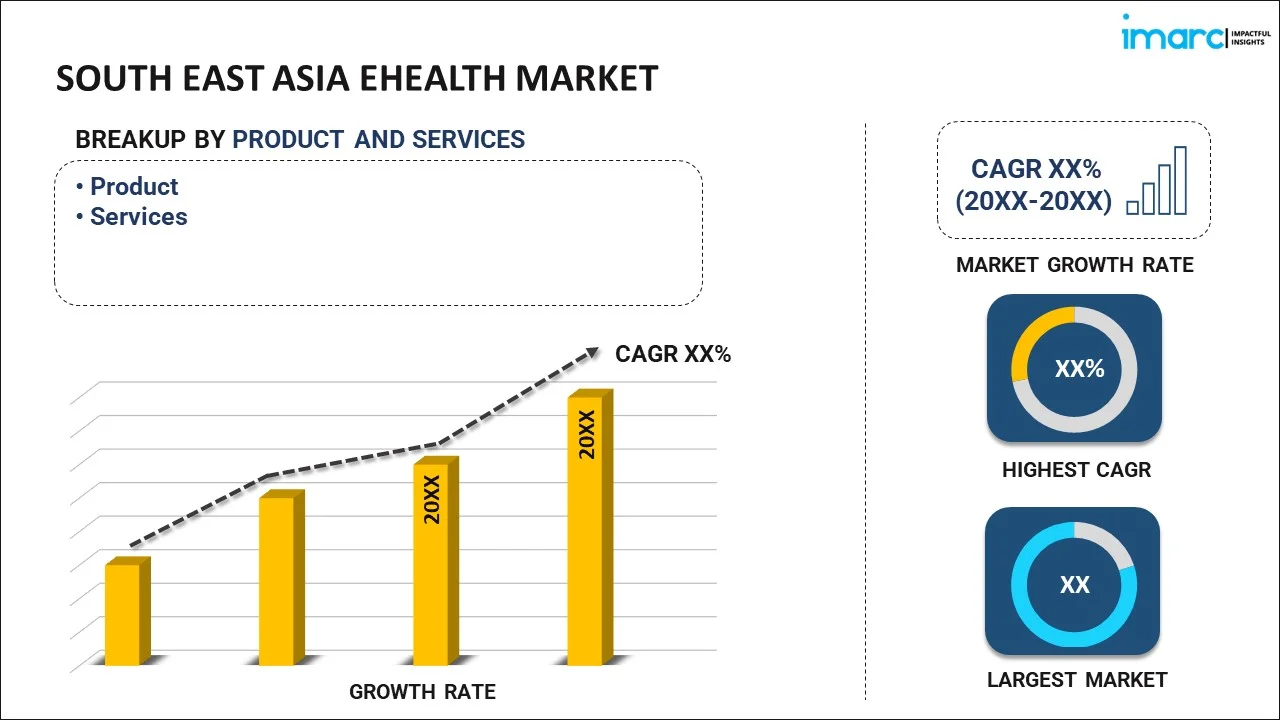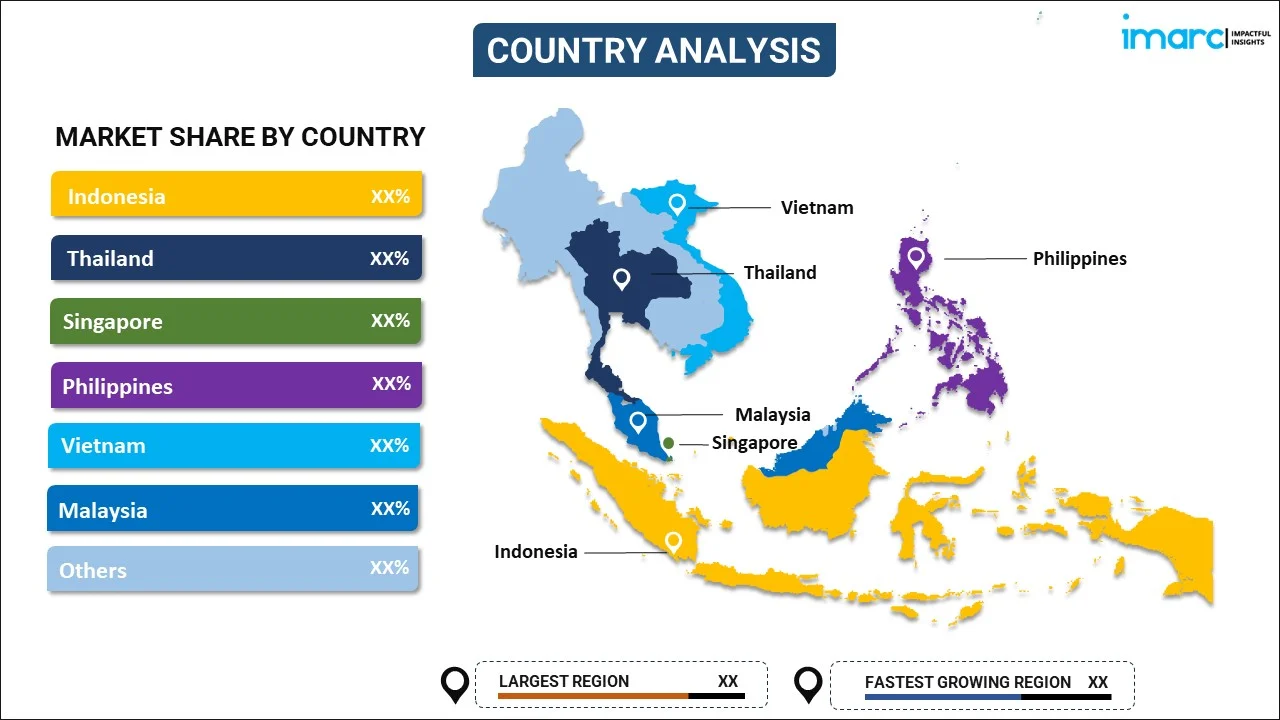
South East Asia eHealth Market Report by Product and Services (Product, Services), End User (Healthcare Providers, Payers, Healthcare Consumers, and Others), and Country 2025-2033
Market Overview:
The South East Asia eHealth market size is projected to exhibit a growth rate (CAGR) of 15.48% during 2025-2033. The increasing demand for advanced healthcare solutions, growing prevalence of chronic diseases in the region, and the use of data analytics and population health management tools represent some of the key factors driving the market.
|
Report Attribute
|
Key Statistics
|
|---|---|
|
Base Year
|
2024 |
|
Forecast Years
|
2025-2033
|
|
Historical Years
|
2019-2024
|
| Market Growth Rate (2025-2033) | 15.48% |
eHealth, short for "electronic health," refers to the use of digital technology, information, and communication tools in the healthcare industry to improve the delivery, management, and monitoring of healthcare services. It encompasses a wide range of digital tools, systems, and processes aimed at enhancing the efficiency, effectiveness, and quality of healthcare. eHealth leverages electronic health records (EHRs), telemedicine, mobile health (mHealth) applications, wearable devices, health information exchange (HIE) platforms, and various other digital innovations to transform and modernize the healthcare industry. EHRs are digital versions of patients' medical records, including their medical history, diagnoses, treatments, and test results. EHR systems facilitate secure and comprehensive storage, retrieval, and sharing of patient information among healthcare providers, improving coordination of care. Moreover, mobile health (mHealth) applications are smartphone and tablet apps designed to support health and wellness. They include fitness tracking apps, medication reminders, symptom checkers, and virtual health coaches, allowing individuals to manage their health and well-being through their mobile devices. On the other hand, HIE platforms enable the secure sharing of patient data among different healthcare organizations and systems.
South East Asia eHealth Market Trends:
The rising demand for healthcare services in South East Asia, driven by population growth, aging demographics, and increased awareness of health issues, is putting pressure on healthcare systems. eHealth solutions are seen as a means to expand access to care, optimize healthcare delivery, and meet the growing demand for services. Additionally, governments in South East Asian countries are actively promoting the digitalization of healthcare as part of their broader efforts to improve healthcare infrastructure and services. National digital health strategies and initiatives are driving investments in eHealth technologies such as electronic health records (EHRs) and telemedicine platforms. Besides, telemedicine is gaining traction in South East Asia, particularly in remote and underserved areas where access to healthcare facilities is limited. Telemedicine services offer virtual consultations, reducing the need for patients to travel long distances for medical care. The COVID-19 pandemic has accelerated the adoption of telemedicine across the region. Moreover, the increasing prevalence of chronic diseases has created a need for remote patient monitoring solutions. eHealth technologies, including wearable devices and remote monitoring platforms, enable healthcare providers to monitor patients' health remotely, reducing hospital readmissions and improving overall care management. In addition, the use of data analytics and population health management tools is enhancing healthcare decision-making and resource allocation in the region. Healthcare providers and governments are leveraging data-driven insights to identify health trends, allocate resources efficiently, and improve public health outcomes. Furthermore, regulatory frameworks and guidelines supporting the adoption of eHealth technologies are being developed and implemented across South East Asia. These regulations provide clarity and support for healthcare providers and technology vendors looking to invest in eHealth solutions.
South East Asia eHealth Market Segmentation:
IMARC Group provides an analysis of the key trends in each segment of the market, along with forecasts at the regional and country levels for 2025-2033. Our report has categorized the market based on product and services and end user.
Product and Services Insights:

- Product
- Electronic Health Records
- ePrescribing
- Clinical Decision Support
- Telemedicine
- Consumer Health Information
- mHealth
- Others
- Services
- Monitoring
- Diagnostic
- Healthcare Strengthening
- Others
The report has provided a detailed breakup and analysis of the market based on the product and services. This includes product (electronic health records, eprescribing, clinical decision support, telemedicine, consumer health information, mhealth, and others) and services (monitoring, diagnostic, healthcare strengthening, and others).
End User Insights:
- Healthcare Providers
- Payers
- Healthcare Consumers
- Others
A detailed breakup and analysis of the market based on the end user have also been provided in the report. This includes healthcare providers, payers, healthcare consumers, and others.
Country Insights:

- Indonesia
- Thailand
- Singapore
- Philippines
- Vietnam
- Malaysia
- Others
The report has also provided a comprehensive analysis of all the major regional markets, which include Indonesia, Thailand, Singapore, Philippines, Vietnam, Malaysia, and Others.
Competitive Landscape:
The market research report has also provided a comprehensive analysis of the competitive landscape in the market. Competitive analysis such as market structure, key player positioning, top winning strategies, competitive dashboard, and company evaluation quadrant has been covered in the report. Also, detailed profiles of all major companies have been provided.
South East Asia eHealth Market Report Coverage:
| Report Features | Details |
|---|---|
| Base Year of the Analysis | 2024 |
| Historical Period | 2019-2024 |
| Forecast Period | 2025-2033 |
| Units | Million USD |
| Scope of the Report | Exploration of Historical and Forecast Trends, Industry Catalysts and Challenges, Segment-Wise Historical and Predictive Market Assessment:
|
| Product and Services Covered |
|
| End Users Covered | Healthcare Providers, Payers, Healthcare Consumers, Others |
| Countries Covered | Indonesia, Thailand, Singapore, Philippines, Vietnam, Malaysia, Others |
| Customization Scope | 10% Free Customization |
| Post-Sale Analyst Support | 10-12 Weeks |
| Delivery Format | PDF and Excel through Email (We can also provide the editable version of the report in PPT/Word format on special request) |
Key Questions Answered in This Report:
- How has the South East Asia eHealth market performed so far and how will it perform in the coming years?
- What has been the impact of COVID-19 on the South East Asia eHealth market?
- What is the breakup of the South East Asia eHealth market on the basis of product and services?
- What is the breakup of the South East Asia eHealth market on the basis of end user?
- What are the various stages in the value chain of the South East Asia eHealth market?
- What are the key driving factors and challenges in the South East Asia eHealth?
- What is the structure of the South East Asia eHealth market and who are the key players?
- What is the degree of competition in the South East Asia eHealth market?
Key Benefits for Stakeholders:
- IMARC’s industry report offers a comprehensive quantitative analysis of various market segments, historical and current market trends, market forecasts, and dynamics of the South East Asia eHealth market from 2019-2033.
- The research report provides the latest information on the market drivers, challenges, and opportunities in the South East Asia eHealth market.
- Porter's five forces analysis assist stakeholders in assessing the impact of new entrants, competitive rivalry, supplier power, buyer power, and the threat of substitution. It helps stakeholders to analyze the level of competition within the South East Asia eHealth industry and its attractiveness.
- Competitive landscape allows stakeholders to understand their competitive environment and provides an insight into the current positions of key players in the market.
Need more help?
- Speak to our experienced analysts for insights on the current market scenarios.
- Include additional segments and countries to customize the report as per your requirement.
- Gain an unparalleled competitive advantage in your domain by understanding how to utilize the report and positively impacting your operations and revenue.
- For further assistance, please connect with our analysts.
 Inquire Before Buying
Inquire Before Buying
 Speak to an Analyst
Speak to an Analyst
 Request Brochure
Request Brochure
 Request Customization
Request Customization




.webp)




.webp)












